Looking at the old cemetery plan and I see several Scandinavian names, buried at the same burial site, in the Argonne area in France. All lost their lives in the fightings which took place here in 1918. I see that they all belonged to 78th Division, American Expeditionary Forces, well, almost everyone. I think for myself, were these Scandinavians in the same Division for a specific reason, or just there because of the amount of emigrants in the region from where they were recruited? Was it a high percentage of emigrants in that specific region, or was it just a coincidence that they ended up in the same burial place?
Introduction
I always find it interesting to look for details regarding the Swedes in WW1, and I am now specifically concentrating on finding information where they were when they fell and where they were buried before they were moved to their final resting places, in the American cemeteries, along the Western Front.
I will use some of the results in my research, to travel to some of the specific places I find, when combining data and put it in a geographical context. This upcoming summer, in July, I will visit almost very American Cemetery in France, along the Western Front, the only one that will not visit this time is Suresnes American Cemetery in Paris, which I will have to do on my next trip.
Method
For this specific post I have used a compilation of data (AEF Resources Map), to find the material, which I later on will present in my results. I am looking through a digital map with data about individuals, units, temporary burial sites, front lines, defense positions and much more, with blueprints about each burial site, from which you can retrieve data and compare it to the data I already have in my research, which will form a larger picture of, where the individuals were, where they fought, where they fell etc.
I collect the data in specific folder on my computer to make it easier to find and compare, to form a small story, from which I later on can take data from, to continue to form an even larger picture about the specific situation in general, but also later on develop side projects, and follow up more facts and info about the American units in WW1.
Result
I especially found a site when looking at the digital map, and I found data, which made me interested in to look more into. It turned out to be a burial site along the Bois-des-loges in France which is situated between the village of Grandpré and Saint-Juvin, and contained soldiers who fought for the 155th Brigade, 78th Division, American Exepditionary Forces (AEF), especially from the 309th and 310th infantry regiment. Among those 72 burials I found several Scandinavian names. In this site there were six soldiers with direct connection to Sweden. Two of them were born in Sweden, and they are already in my project, and four of them were born in US by Swedish parents, who emigrated to US from Sweden late 19th century.
Just around 600 m from that specific burial site there were also one more individual burial place, which turned out to have contained one of the Swedish born soldiers that I have in my project as well.
All those seven soldiers belonged to the 78th Division except one, who belonged to the 86th Division, which I found out, served as a unit from where reserves were sent out to the other units, so most probable this soldier fought along those from the 78th Division.
Below you will find a short summary about the individual soldiers I found on the specific blueprint, who has connection to Sweden. I have chosen some files connected to each soldier, and mention some basic facts about their background.
Below you will see three snippets of the burial site, and the view around it.
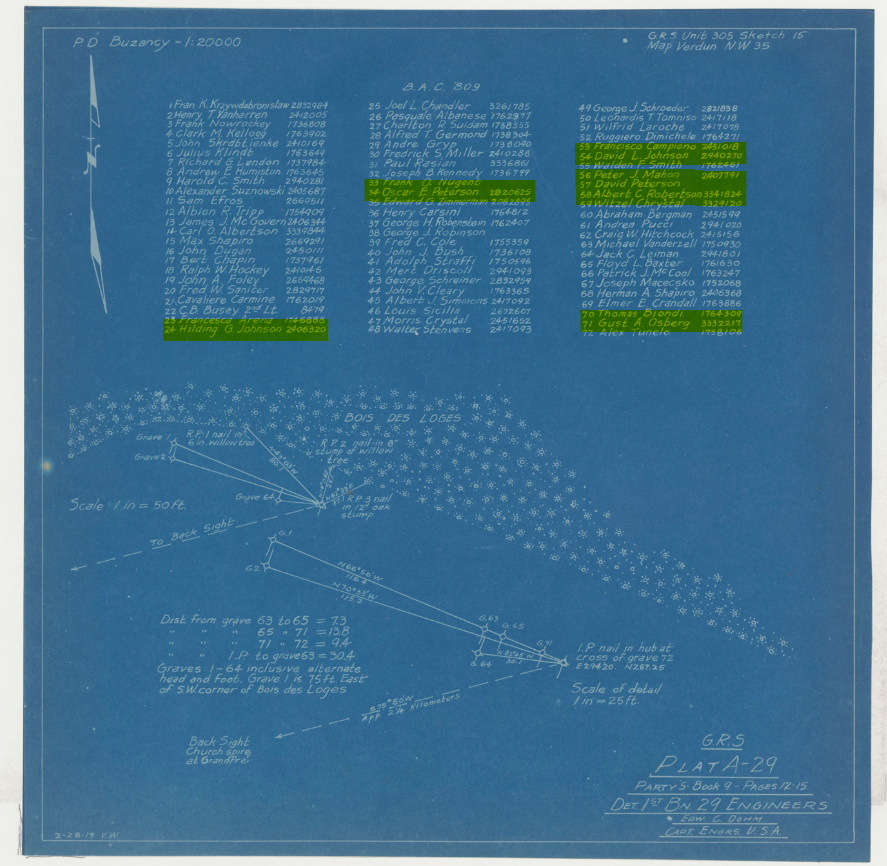
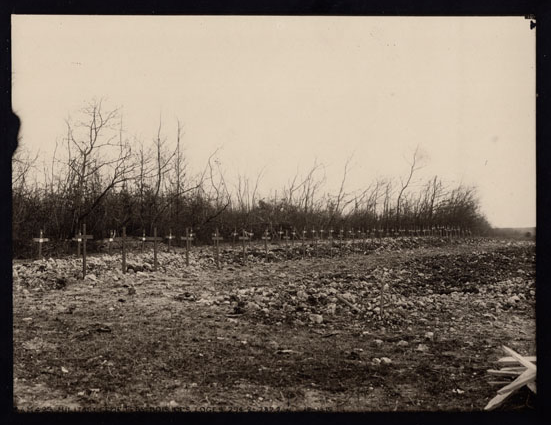

Here are the soldiers found on the blueprint, who are connected to Sweden.
Gust A Osberg (Gustaf Adolf Åsberg) – Born in Skaraborg County – Went to US from Sweden 1911. Lived in Rockford, Illinois. Fought for 309th Inf, 78th Div.
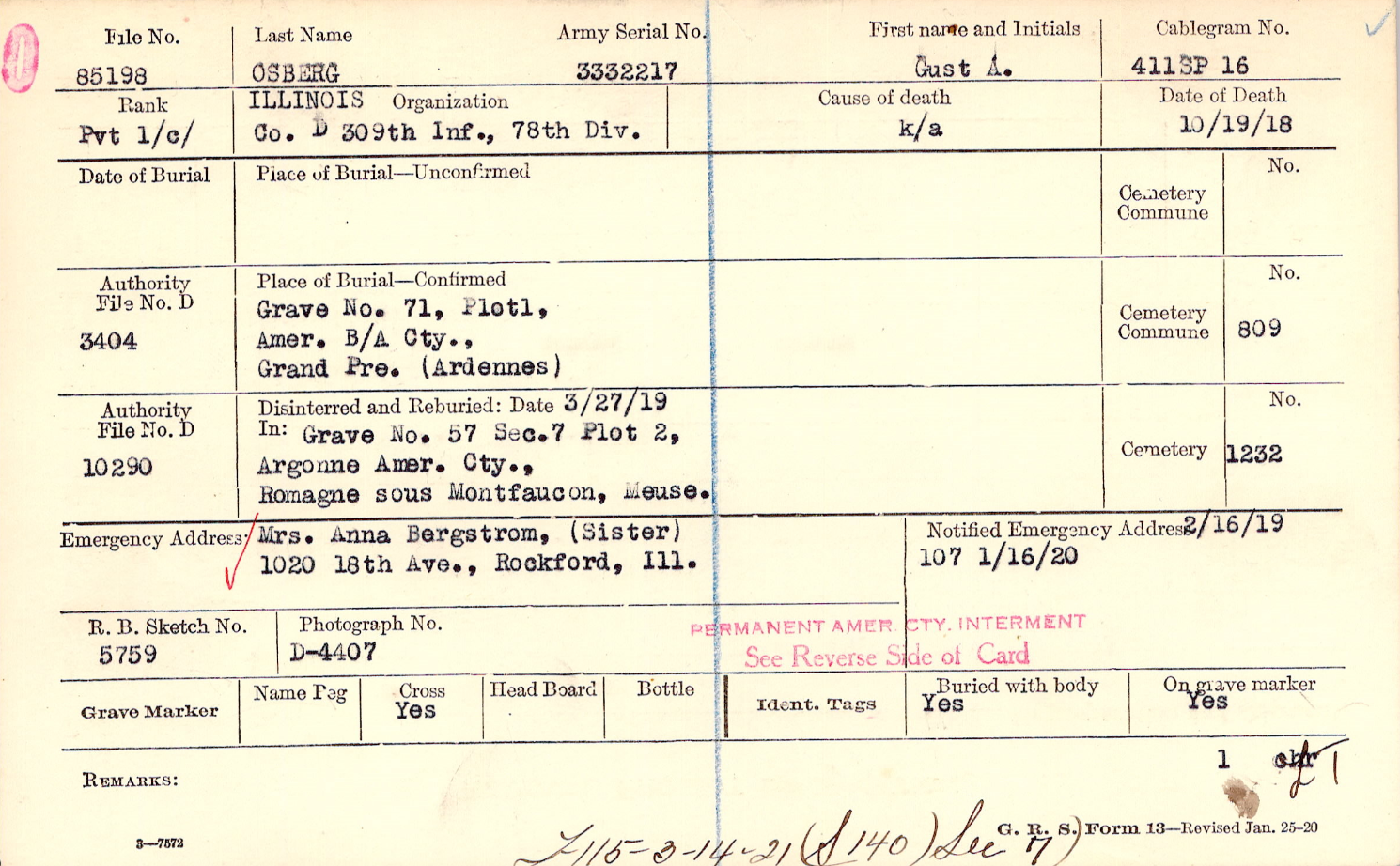

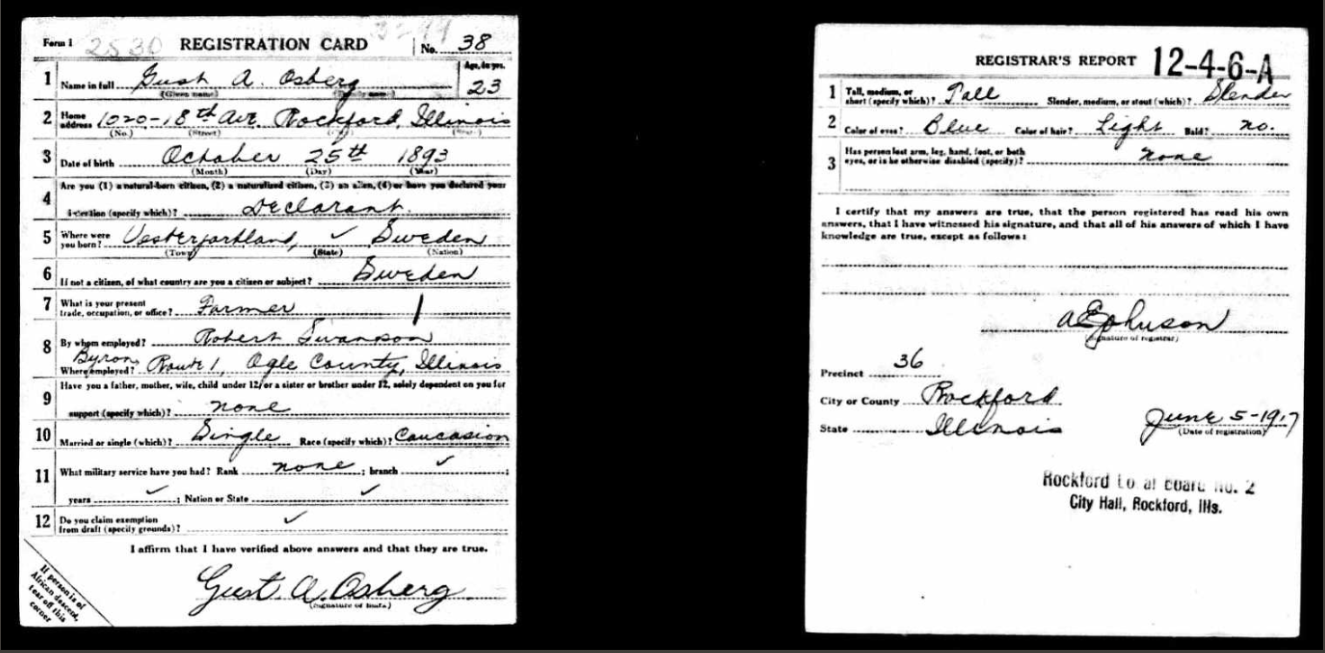
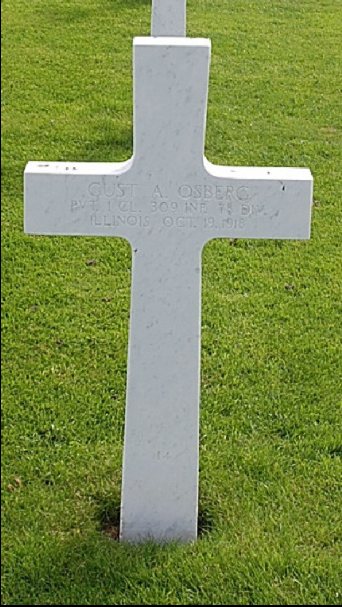
Hilding G Johnson (Hilding Gotthard Johnsson) – Born in Skåne County – Went to US from Sweden 1905. Lived in Brooklyn, New York. Fought for 310th Inf, 78th Div.
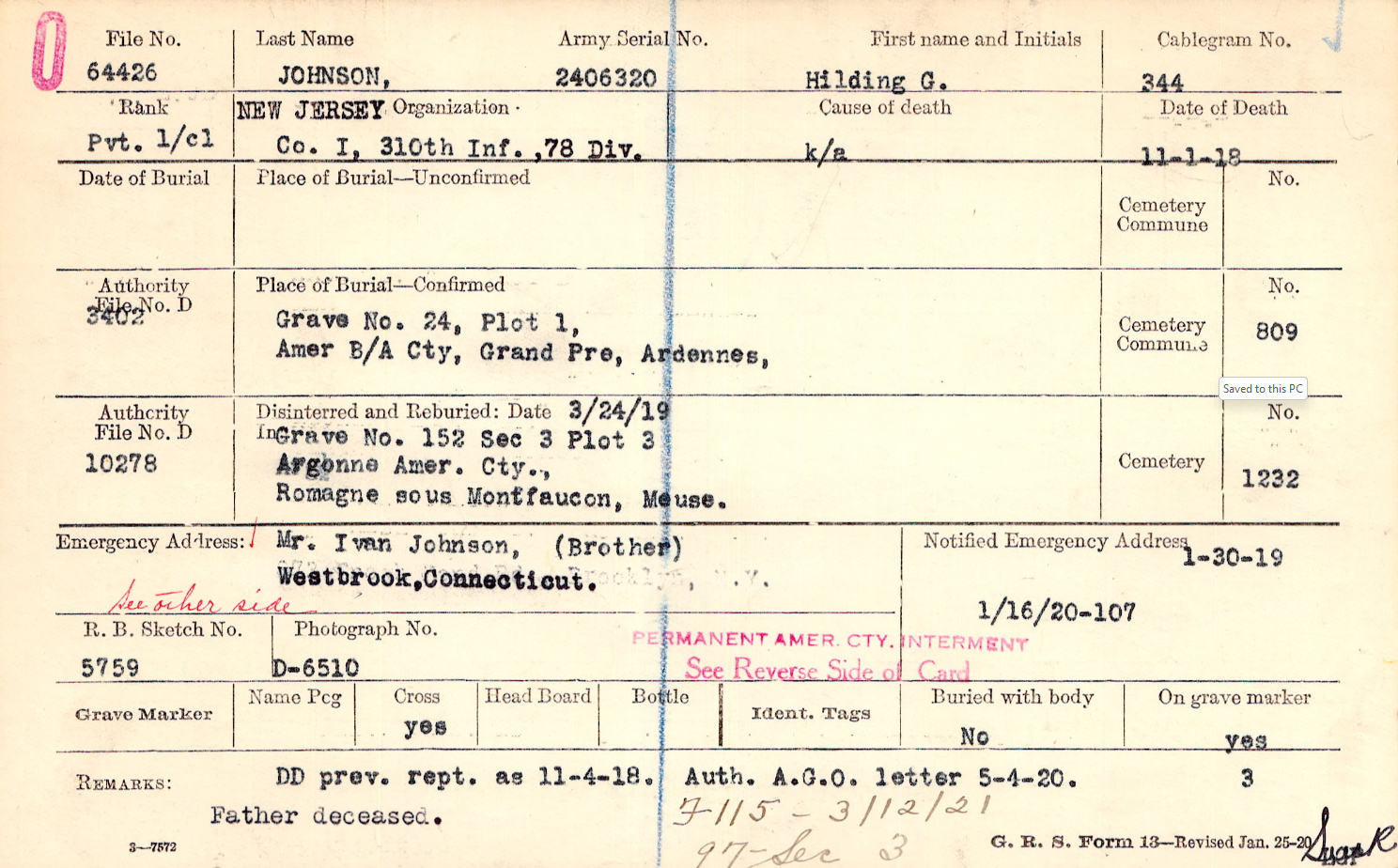
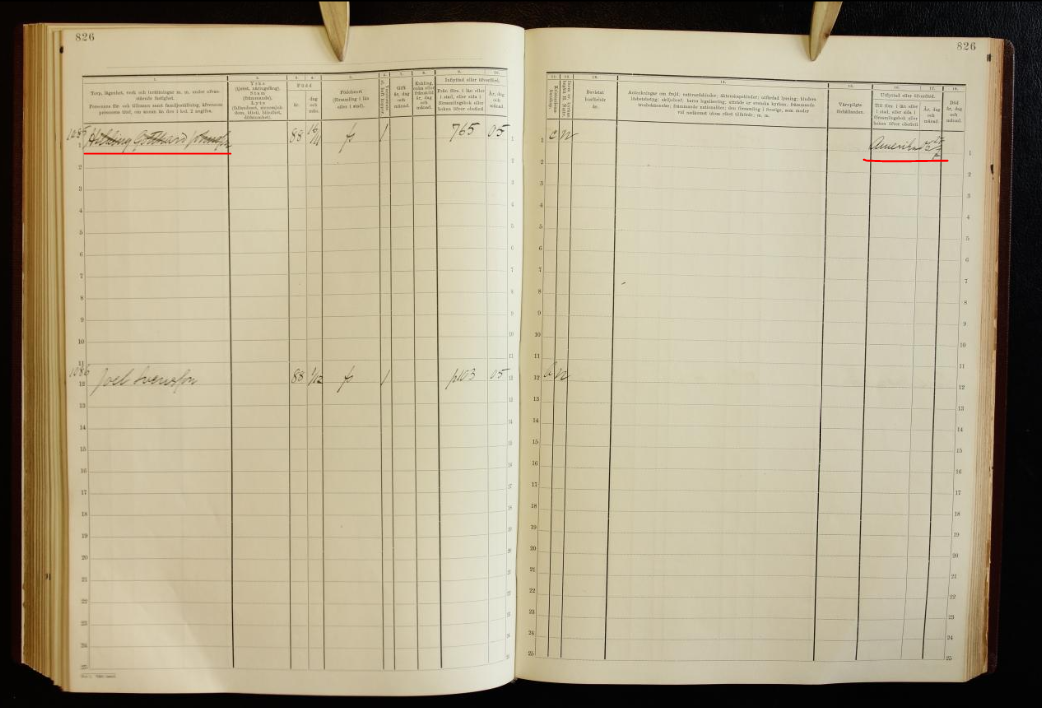
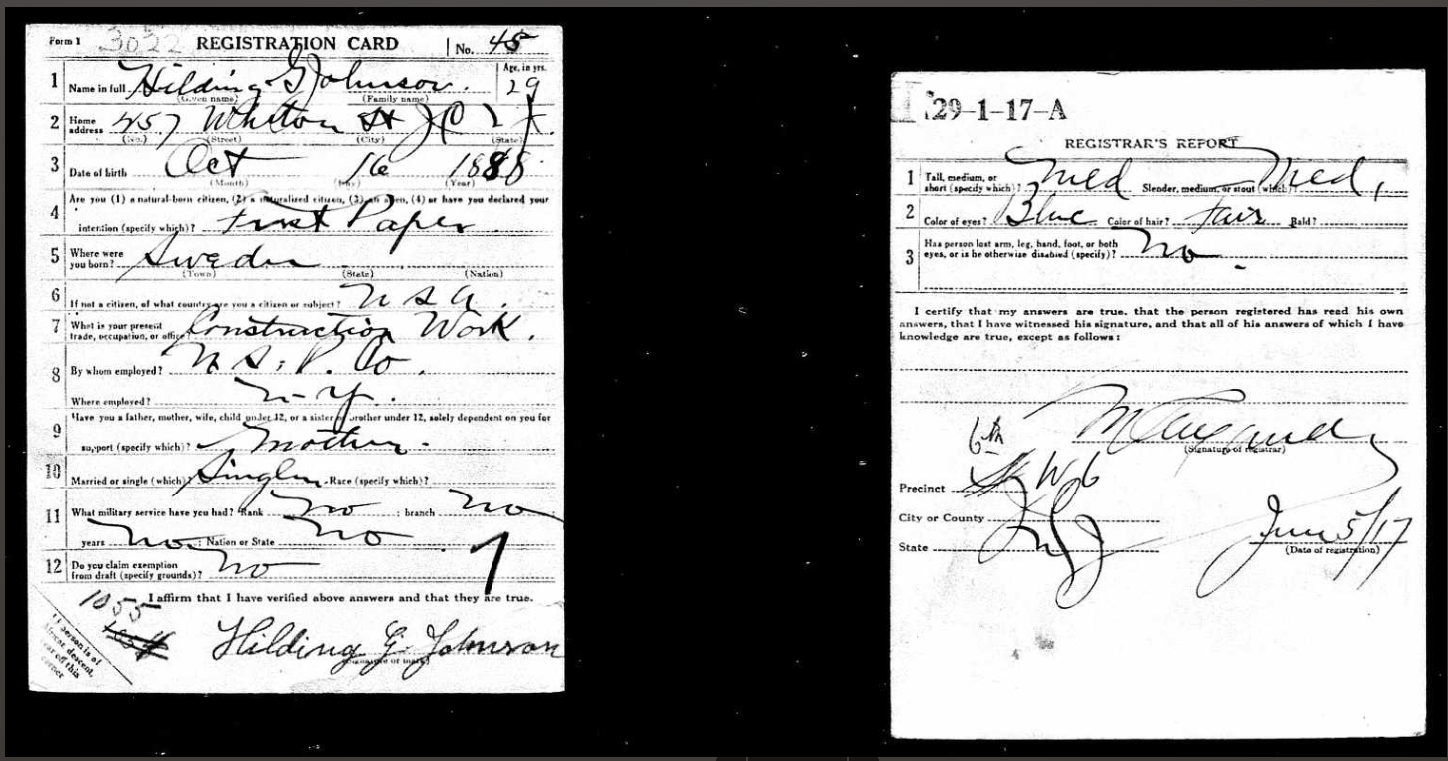

Oscar E Peterson (Oscar Edward Peterson) Born in Lake Emma, Minnesota. Mother came from Norway, and father came from Sweden to US around 1883. Oscar Lived in Emmaville, Minnesota. Fought for 309th Inf, 78th Div.




David L Johnson (Probably David Leonard Johnson) Born in Rochester, Pennsylvania, US. Mother and father went from Sweden to US in 1883. David lived in Rochester, Pennsylvania. Fought for 310th Inf, 78th Div.
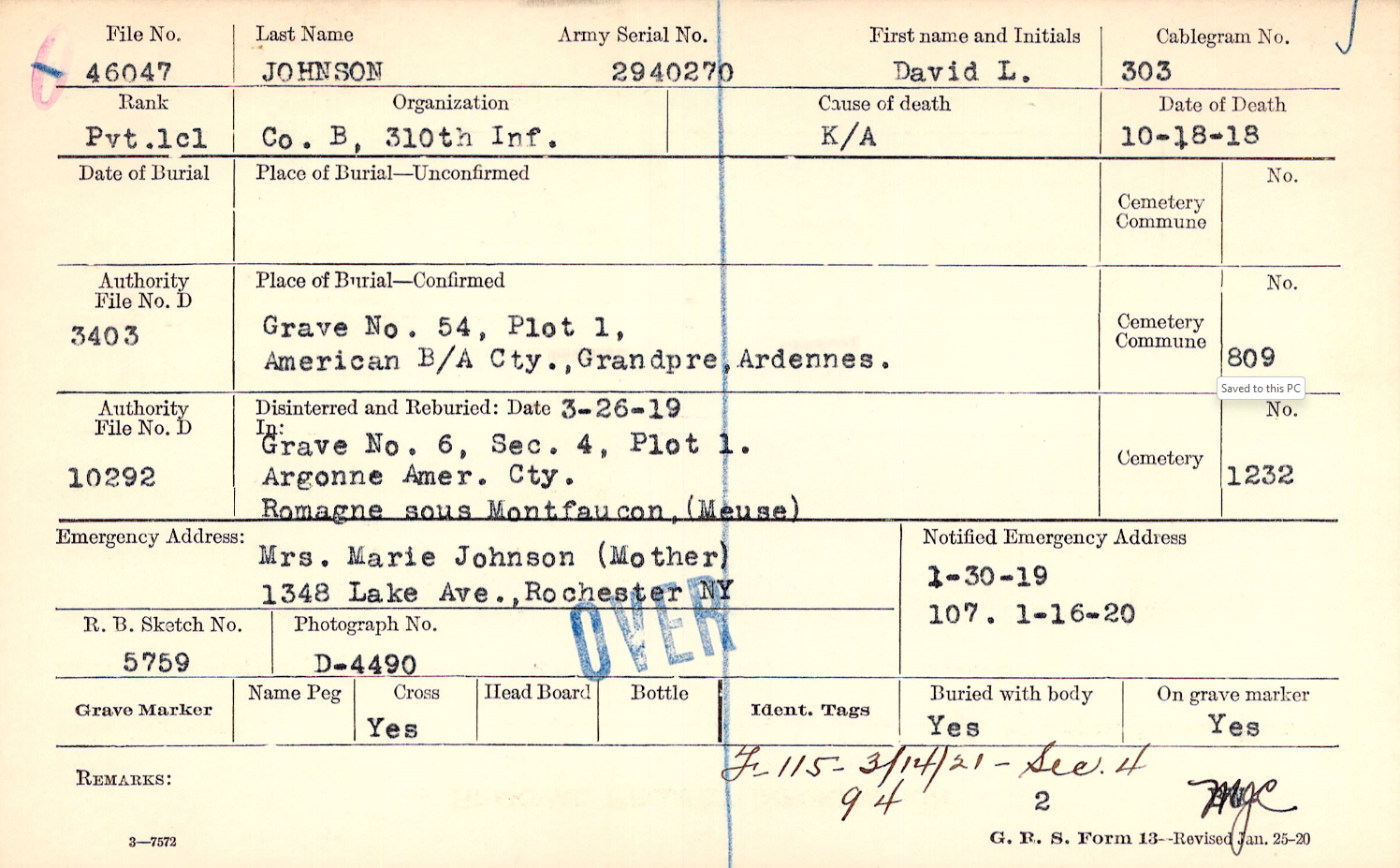

David I Peterson (David Isidor Peterson) Born in Douglas county, Minnesota. Mother from Sandviken, and Father (probably born in Broby, Skaraborg County) from Grangärde, Dalarna, Sweden, went to US around 1888. David lived in Nelson, Minnesota. Fought for 343rd Inf, 86th Div.

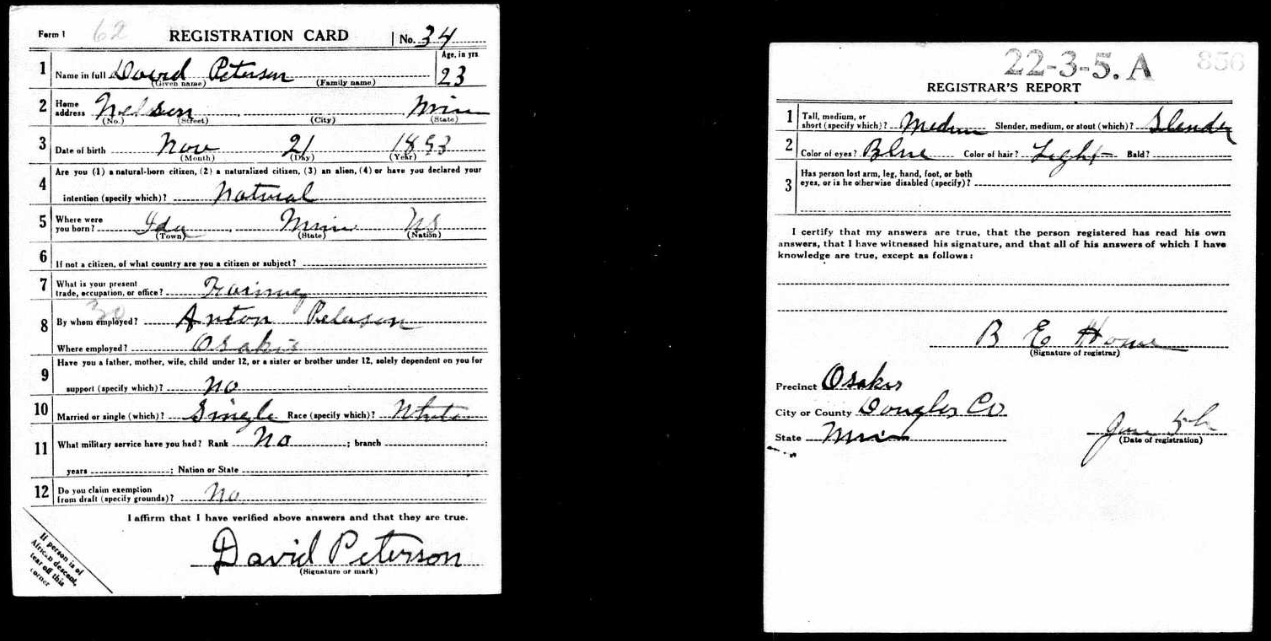
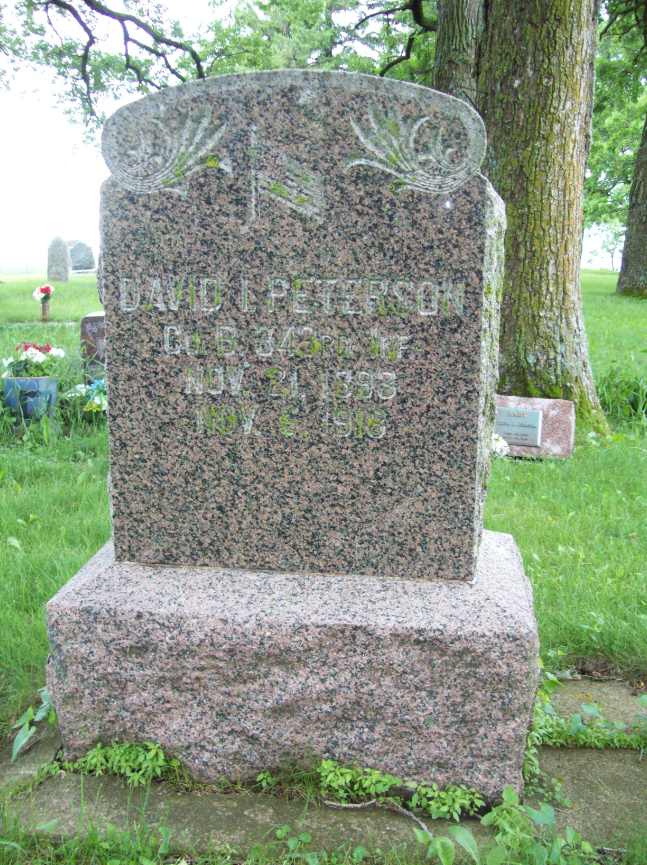
Albert C Robertson (Albert Carl Robertson) Born in Duluth, Minnesota, Mother from Linköping, Östergötland County, Sweden, and father Charles August, most probable born in Sweden 1866. They went to US in 1890, but Hedvig, who actually is named Hedda in Sweden, left in 1886 according to the church books. Albert lived in Duluth, Minnesota. Fought for 310th Inf, 78th Div.
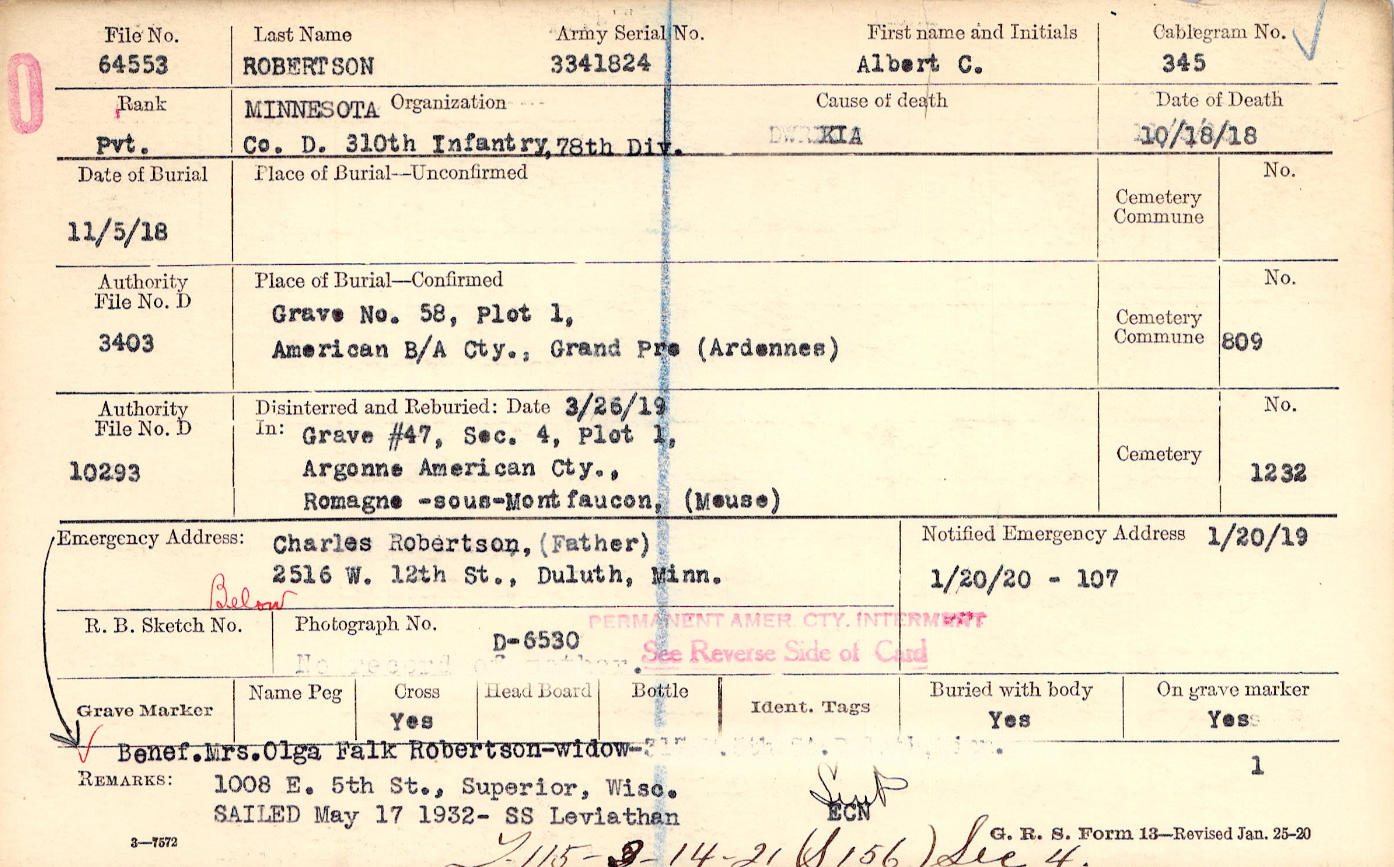


The above mentioned individuals are buried in the same place, in the field, near the wood, according to cemetery plan mentioned above, in the beginning.
600 m to the east there are one burial, together with only another individual, and that is the Swedish born soldier Knute S Johnson (Knut Sigfrid Johansson) He left Sweden probably around 1911, the same year he actually should have made his conscript period. He is mentioned as absent in the church books. Knute lived in Hennepin, Minnesota. Fought for 309th Inf, 78th Div.
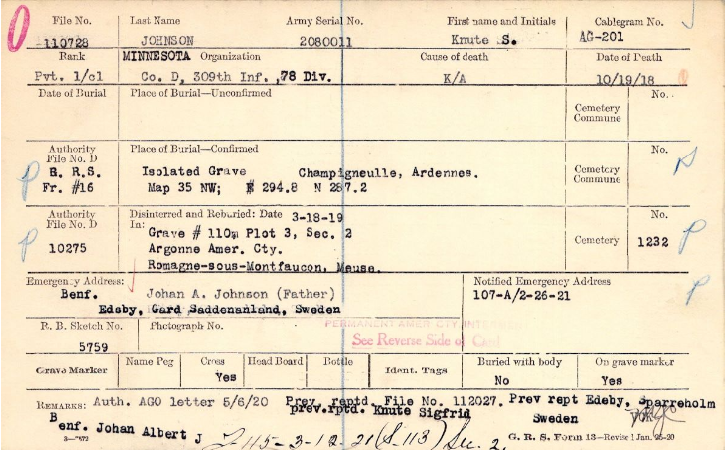

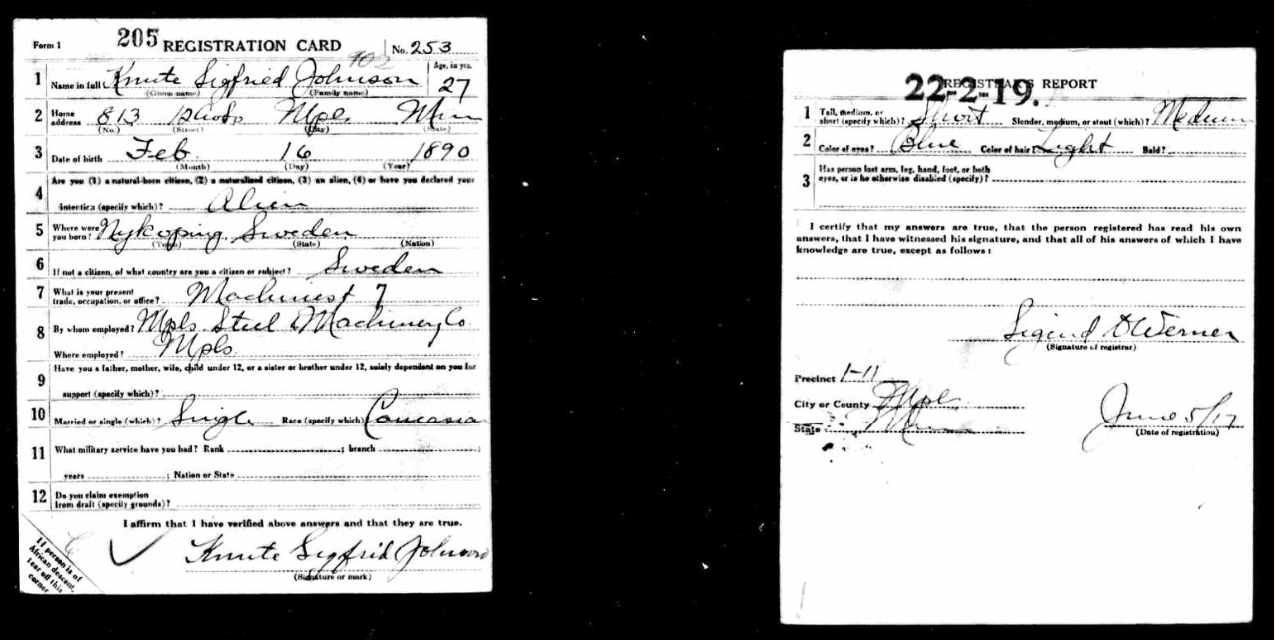

All the above mentioned soldiers was killed in action between 18th of October and 5th of November, 1918. According to the diary of the 78th Division it is told that the Division relieved the 77th Division in the area of Petit Talma – Chevieres – Grandpré and St. Juvin, east of Argonne Wood, already on the 15th of October.
On the 16th of October the Bois-des-loges was one of the main objectives. The unit penetrated the wood in the initial attack, but due to heavy indirect fire and machine gun fire from the enemy, the unit was forced to withdrawn on October 20th, according to the orders from the Divisional Headquarters, due to heavy losses.
Observations
As I have mentioned above that I thought it was quite interesting that quite many Scandinavian related individuals were buried together in a quite small burial plot, belonging to soldiers from 78th Division. In the plot there are also soldiers from Denmark and Norway. The soldiers are from different states in US, from regions that, at the time, had a quite large group of immigrants, especially from Scandinavia. It correlates with my simple summary of where the Swedes in my project moved to in US, when the emigrated.
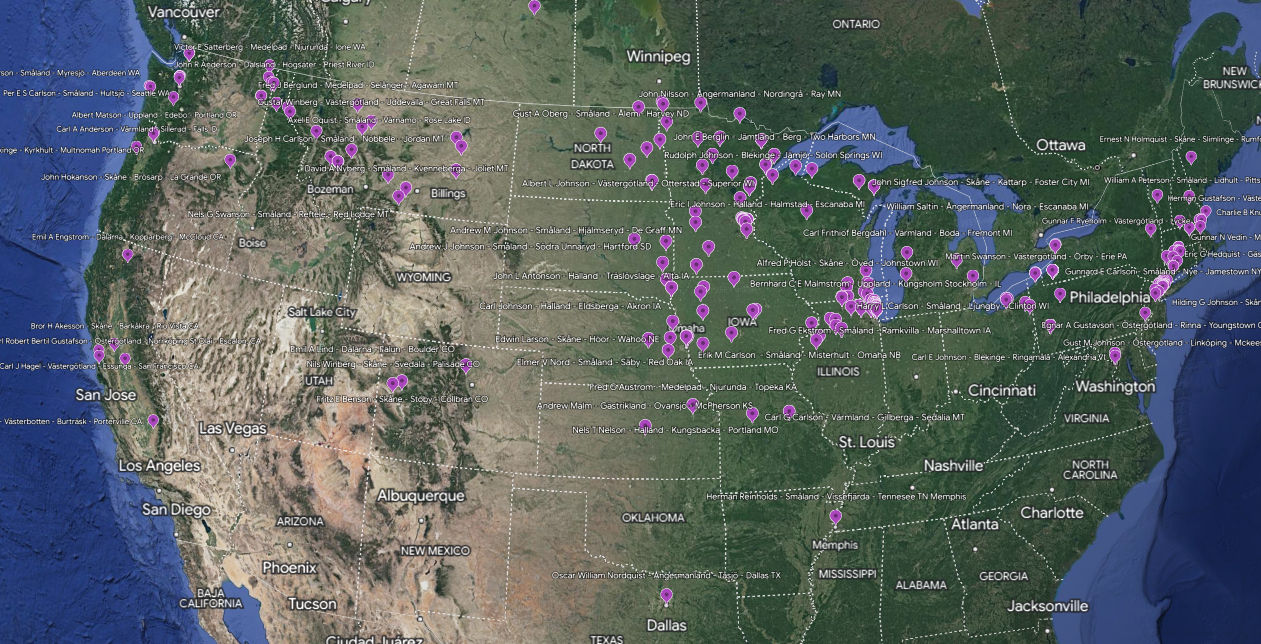
The 78th Divison was formed in New Jersey, and contained mainly of individuals from New York, New Jersey and Delaware, and later supplemented by men from New England States (Connecticut, Maine, Massachusetts, New Hampshire, Rhode Island, and Vermont) and Illinois.
If I look for scandinavian names in the “Soldiers of the Great War” collection, it lines up well with the above mentioned states, to contain individuals with Scandinavian names who fell in the war.
In my own research, quite few, of those in total 270 Swedish born soldiers who fell for the AEF, and are buried at the Western Front in France and Belgium, belonged to the 78th Division.
Discussion-Conclusion
I will or cannot draw any specific conclusions of the above mentioned facts due to the amount of collected values in this specific situation but it is interesting to think about it.
Four of those seven soldiers mentioned above lived in Minnesota, not mentioned as a state the Division was formed from, but, without knowing, I think soldiers from Minnesota could have been a quite large group of men within 78th Division, but I will try to find some kind of roster, to see if I can find more information about that.
In the specific situation I find it quite interesting that around 9% of the soldiers in that small plot had connections to Sweden, which highly likely is a coincidence.
I will take this small summary with me in my research, and I will of course try to visit this little spot, on the hill, close to Bois-des-loges, on my upcoming trip this summer, and maybe see the terrain from their point of view, once upon a time, in 1918. May they rest in peace.
Sources:
- AEF Resources Map
- westernfront.se
- Ancestry
- Findagrave
- Arkiv Digital
- Brief histories of divisions, US Army, 1917-1918
- US National Archives
